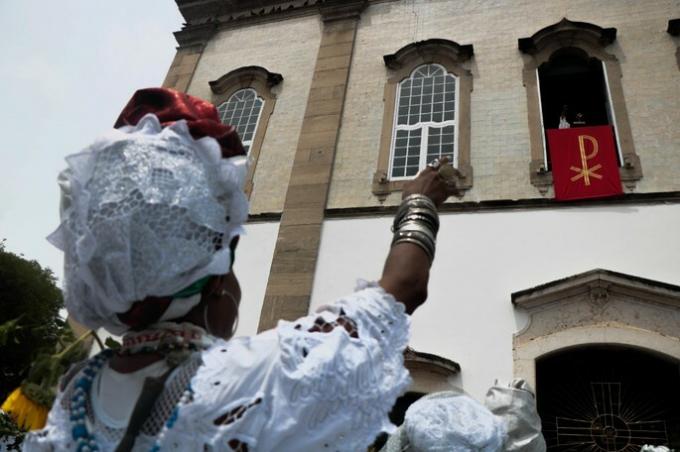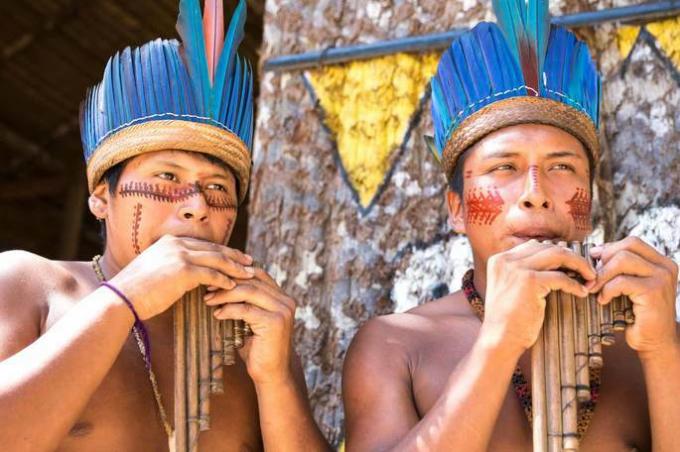O syncretism it is characterized by the union of distinct cultural, religious and ideological elements that will form a new culture, religion or society.
Religious syncretism consists of the presence of a ritual, idea, organization, symbols or artistic objects that originate from one religion and which are incorporated into another.
religious syncretism
Human beings use elements of their environment and their culture to honor their gods or god. Thus, there is no such thing as a pure religion or one that does not have a mixture of existing cults.
Therefore, we can say that in all religions we find traces of religious syncretism.
Let's look at some examples:
Christianity was born out of Judaism, and one of the pillars of this belief, the Torah, is part of the set of Christian sacred books, the Bible. Likewise, the great Jewish feast, Passover, is present in Christianity, after being re-signified by Christians.
Likewise, the Catholic Church took elements of the Roman Empire's administration by absorbing its organization. An example is the institution of a top leader, the Pontiff. This title, however, comes from the polytheistic Roman religion and belonged to the most prestigious priest of the Pontifical College.
The mixture of elements can be seen in all existing religions, as there is no pure religion.
Candomblé is also a syncretized religion. In Africa, each tribe worshiped only one orixá, but here in Brazil, as several nations mingled, the way was to praise as many orixás as possible so that everyone felt welcomed.
Religious syncretism in Brazil
The characteristics of Portuguese colonization gave rise to Brazilian religious syncretism.
One of the objectives of the great navigations was to Christianize the peoples who were found in the new territories. In this way, the indigenous people were the first to be catechized.
In order to explain the Christian doctrine to them, the Jesuit priests used indigenous cultural elements. This gave rise, for example, to legends invented by religious that were incorporated into the indigenous repertoire, such as the Aó-aó.
Enslaved black Africans went through the same process, which gave rise to Candomblé, an Afro-Brazilian religion. Upon arriving at the colony, they revived their rituals, symbols and festivals they used to do in Africa, but adapting them to the reality of America. An example would be the offerings to the orixás that started to incorporate local foods.
Furthermore, intimidated by the punishments, many enslaved people apparently embraced the Catholic religion, but kept the cult of their orixás. Thus began the identification between Catholic saints and orixás, the processions of the patron saint with feasts for their deities, among other practices.

It wasn't just African religions that were syncretized. Currently, we observe that there is religious syncretism between Brazilian neo-Pentecostal churches, Catholicism and Afro-Brazilian religions.
Certain Brazilian neo-Pentecostal churches use Catholic practices such as blessing objects such as rock salt, roses and water glasses with the purpose of transmitting grace to the faithful. Likewise, when referring to the devil, they misquote the orixás of Candomblé and entities from Umbanda.
Thus, we realize that religious syncretism is widespread in the country.
Syncretism in Umbanda
Umbanda is a Brazilian religion, with an African matrix, where several syncretisms occur.
This belief has elements of Kardecism, Candomblé, indigenous religion, Catholicism, among other cults. Syncretism occurs both at the doctrinal level with elements of monotheism, reincarnation and figures to be worshiped, as well as in the external aspect, as its celebrations take place in a Casa or Terreiro.
See too: Umbanda
cultural syncretism
Cultural syncretism or cultural mestizaje is a term used to explain the societies that were created in Latin America.
These societies were born from the union of Amerindian, European and African cultures, and each one of them had its particularity. After all, in these groups there are many differences.
However, we can argue that this term could also be used for European societies. Take the example of France, which was inhabited by the Gauls and other peoples, who merged with the Roman Empire. Later, they adopted Christianity, sheltered Jews and countless other peoples that resulted in the French people.
It is important to remember that, like religions, there is no pure race or pure people.
Aesthetic syncretism
Aesthetic syncretism consists of the intersection of various artistic and cultural influences that will generate a new artistic movement.
Generally, this is the period when a new artistic movement is being generated, as is the case of Brazilian pre-modernism, in the 10s. This period is not considered an independent art movement because it is influenced by various schools such as Neo-Realism, Neo-Parnasianism, Neo-Symbolism.
In the 1920s, these characteristics had already been absorbed and formed what was consolidated as Brazilian Modernism.
We have more texts on the subject for you:
- Orixás do Brasil
- congada
- Candomblé
- Cultural diversity



